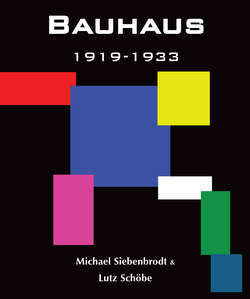Читать книгу Bauhaus. 1919-1933 - Michael Siebenbrodt - Страница 14
На сайте Литреса книга снята с продажи.
History of the Bauhaus
Bauhaus Dessau: Academy for Design (1925 to 1932)
Laboratories for Industry – Workshop Work
ОглавлениеBalanced economic and pedagogical considerations had preceded the structural changes as well as reorganisation of the curriculum in 1929. Among other things, this resulted in the fact that some of the Weimar workshops such as stained glass, painting, and bookbinding were not reinstated in Dessau. The stone sculpture and woodcarving department became a plastic workshop and the graphic printing department was replaced by the printing and advertising workshop. While it was possible in the new Dessau building to renovate the remaining workshops partially according to modern ideas, this was not true for the ceramics workshop, which was not continued in Dessau.
The interim solution in the city described earlier ended in October 1926 when the workshops moved into the Bauhaus building. After the opening of the new school building with its attendant publicity in December of the same year, all practical, manual trade subjects could be more strictly systematised and even more impulses from science could be picked up. With the orientation of workshop education towards industrial design, Gropius’s principle of “nature research” was raised to a didactic model. According to it, a thing is defined “by its nature. In order to design it so that it functions – a container, a chair, a house – its nature must first be researched.”[7] This approach was one of the things that created completely new jobs at the end of individual educational paths. The Bauhaus attempted to conceive serial production appropriate for industrial manufacture in the so-called “laboratory workshops”, which were to be offered as high-quality and affordable mass products to a broad class of consumers. A precondition to the purchase of such furniture and objects for daily use, however, was the potential buyer’s declared aesthetic belief in an industrially-based culture. Appropriate PR work was launched which included a stronger use of Bauhaus Ltd, which had been founded in 1925. It was mostly concerned with the marketing process for the products developed in the Bauhaus and with furthering collaboration with industry.
Industry and the beginning of urban construction were thus the focus of interest for the Bauhaus in Dessau. The central German industrial zone in which the Bauhaus had established itself offered more opportunities than ever before to push the combination of art and technology into a “new unity”, and to connect the technical know-how of industrial production with the aesthetic modernism of the Bauhaus designs. But a broader collaboration between the Bauhaus as a “laboratory for industry” (as Gropius put it) and sectors of the industrial economy did not come about. Comprehensive collaboration with the gas device and aircraft manufacturer Junkers, for instance, would have been obvious in many areas, such as dwelling construction, aircraft interior furnishing, advertising and marketing or furniture construction. But the collaboration was reduced to individual projects and partial influencing. The reasons for this may have been less the lack of mutual support and respect than the differing economic interests of the company and the school, as well as the competitive situation which was eventually created by the avant-garde exploratory spirit of both parties.
Masters of the Bauhaus on the roof of the Bauhaus building on the December 4th, 1926, photograph taken using automatic shutter release (l-r: Josef Albers, Hinnerk Scheper, Georg Muche, László Moholy-Nagy, Herbert Bayer, Joost Schmidt, Walter Gropius, Marcel Breuer, Wassily Kandinsky, Paul Klee, Lyonel Feininger, Gunta Stölzl, Oskar Schlemmer)
7
Walter Gropius, Grundsätze der Bauhausproduktion. In: Neue Erziehung (Jena), 7, 1925, Nr. 6, p.656.
